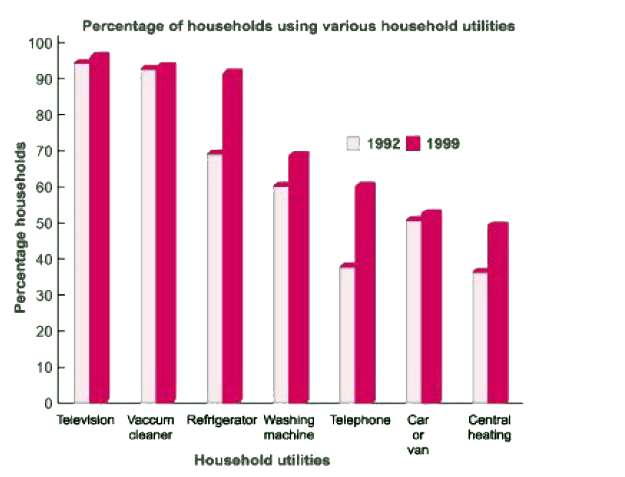If the number of households increases from 403 million in 1992 to 600 million in 1999, then what would be the number of new telephones installed (in million) ? (Assuming one telephone per household)

Step by step video & image solution for If the number of households increases from 403 million in 1992 to 600 million in 1999, then what would be the number of new telephones installed (in million) ? (Assuming one telephone per household) by Maths experts to help you in doubts & scoring excellent marks in Class 14 exams.
Updated on:21/07/2023Topper's Solved these Questions
- BAR CHARTBOOK - ARIHANT SSCCHAPTER - BAR CHARTEXERCISE - Base Level Questions
22 Videos
- BAR CHARTBOOK - ARIHANT SSCCHAPTER - BAR CHARTEXERCISE - Higher Skill Level Questions
20 Videos
- AVERAGESBOOK - ARIHANT SSCCHAPTER - AVERAGESEXERCISE - Final Round
27 Videos
- BOATS AND STREAMS BOOK - ARIHANT SSCCHAPTER - BOATS AND STREAMS EXERCISE - EXERCISE HIGHER SKILL LEVEL QUESTIONS
9 Videos
Similar Questions
Knowledge Check
The questions below consist of a set of labelled sentences. These sentences, when properly sequenced form a coherent paragraph. Select the most logical order of sentences from among the options.
P: There is a glimmer of hope with India registering a slight drop in the number of new tuberculosis cases and TB deaths in 2016 compared with 2015
Q: Incidence estimates for India were considered interim, pending a national TB prevalence survey scheduled for 2017-2018.
R: in terms of mortality, the drop was from 0.51 million in 2015 to 0.43 million in 2016.
S: From an estimated 2.84 million new cases in 2015, the number dropped marginally to 2.79 million in 2016, according to the World Health Organisation.s Global tuberculosis report, 2017.ARQPSBPSQRCSPORDSRQPThe question below consists of a set of labelled sentences. These sentences, when properly sequenced form a coherent paragraph. Select the most logical order of sentences from among the options.
P: There is a glimmer of hope with India registering a slight drop
in the number of new tuberculosis cases and TB deaths in 2016 compared with 2015.
Q: Incidence estimates for India were considered interim, pending a national TB prevalence survey scheduled for 2017-2018.
R: In terms of mortality, the drop was from 0.51 million in 2015 to
0.43 million in 2016.
S: From an estimated 2.84 million new cases in 2015, the number dropped marginally to 2.79 million in 2016, according to the World Health Organisation's Global tuberculosis report, 2017.Aa) RQPSBb) PSQRCc) SPQRDd) SRQPAs per the International Labour Organisation (ILO)'s report "World Employment and Social Outlook Trends 2018", it is projected that the number of unemployed persons in India is expected to rise from 18.3 million in 2017 to 18.6 million in 2018 and 18.9 million by 2019. However, unemployment rate expected to remain static at ..................... percent during the same period.
A5.5 per centB2.5 per centC3.5 per centD0.5 per cent
India’s population has been steadily increasing from 439 millions in 1961 to 1028 millions in 2001. Find the total increase in population from 1961 to 2001. What is the increase in population?
View SolutionTwo times a number is a 100% increase in the number. If we take half the number what would be the decrease in per cent!
View SolutionConvert the following numbers into figure form
Five million eight thousand seventy one
View SolutionIn 1998, ratio of the numbers of students taking examinations in x and z states are respectively 3:5:6. Next year, the numbers of students are increased by 20%, 10% and 20% respectively. If ratio of the numbers of students in states x and z is 1 : 2, then find the number of students who sit to take examination in 1998.
View SolutionIf India's population is increasing at the rate of 13.6 million per year, then what percentage of total increase in would's population in one caalender year is contributed by the Indians
View Solution

